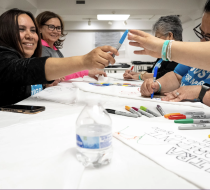Art activists decorate bandanas to protest violence against women farmworkers Favorite
Sitting at a folding table in the basement of Trinity Episcopal Church in downtown Columbus, Monica Jacobo used a felt tip marker to write the words “No means no!” on a white bandana.
Jacobo, 57, was among nearly a dozen people participating in an art-activism event Thursday to raise awareness about workplace sexual violence against women farmworkers. Participants decorated bandanas used by women in agriculture as protection against pesticides and UV rays — and now also against unwanted sexual advances — by drawing and writing messages of solidarity and hope.
“No two bandanas are the same — each one of them is like an original,” said Jacobo, who lives in Fremont, Sandusky County. “A lot of people don't think about it (sexual violence against farmworkers) until it's brought to their attention.”
The bandana decorating was organized by the Ohio-based national nonprofit Justice For Migrant Women, which has programs related to violence, pay equity, mental health and other topics. It took place on the sidelines of a larger event, the Ohio Alliance to End Sexual Violence’s Advocacy Day, during which around 100 survivors and advocates met with lawmakers at the Ohio Statehouse as part of Sexual Assault Awareness Month.
Farmworker women face unique challenges regarding harassment in the workplace, according to Amelia Reyna, 67, a Justice For Migrant Women advisory board member who is also from Fremont.
“A lot of people don’t want to speak out,” Reyna told The Dispatch in Spanish. “They’re afraid because some are undocumented, or because they don’t know English.”
Of the approximately 2.9 million agricultural workers in the U.S., around 70% are foreign born, mostly from Mexico, according to the Texas-based National Center for Farmworker Health. Around half of agricultural workers in the U.S. are undocumented, according to the U.S. Department of Agriculture, and 44% of migrant farmworkers lived below the federal poverty level in 2019-20, according to the U.S. Department of Labor.
Many migrant farmworkers live in northwestern Ohio, but they are found throughout the state. Almost one-third of farmworkers nationally are women, according to the U.S. Department of Labor.
Data on sexual violence in the agricultural setting is hard to come by because much goes unreported, but studies from around the country suggest that between 30% and 80% of farmworkers are sexually harassed on the job.
To combat sexual violence, Justice for Migrant Women calls on national watchdogs like the federal Equal Employment Opportunity Commission and U.S. Department of Labor to prioritize investigations involving farmworkers and service industry workers. It also advocates for greater access to mental health services.
The Bandana Project was started 15 years ago by the organization's founder, Mónica Ramírez, and has collected thousands of bandanas so far, according to Maeve Elder, 26, a program associate.
“These bandanas are … a show of support to victims whose shame and fear prevents them from taking action,” according to the organization’s website.
Elder said the bandanas have been displayed in various temporary exhibits, including at the National Mall in Washington, D.C., and the organization hopes to eventually create a permanent installment.
Looking around at the bandanas the other participants produced on Thursday, Jacobo issued a positive critique.
"Some people are better artists than they give themselves credit for," she said.








